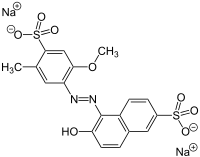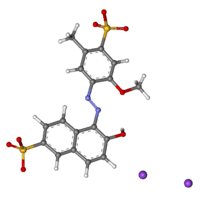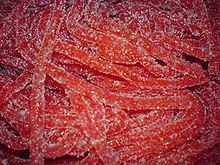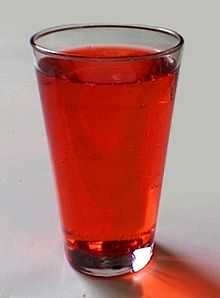Allura Red AC
 | |
 | |
| Names | |
|---|---|
| IUPAC name
Disodium 6-hydroxy-5-[(2-methoxy-5-methyl-4-sulfophenyl)azo]-2-naphthalenesulfonate | |
| Other names
Allura Red, Food Red 17, C.I. 16035, FD&C Red 40, E129, 2-naphthalenesulfonic acid disodium salt | |
| Identifiers | |
| 25956-17-6 | |
| ChEMBL | ChEMBL174821 |
| ChemSpider | 11588224 |
| |
| Jmol-3D images | Image |
| PubChem | 6093299 |
| |
| UNII | WZB9127XOA |
| Properties | |
| Molecular formula |
C18H14N2Na2O8S2 |
| Molar mass | 496.42 g·mol−1 |
| Appearance | Red powder |
| Melting point | >300°C |
| Hazards | |
| NFPA 704 | |
| Except where noted otherwise, data is given for materials in their standard state (at 25 °C (77 °F), 100 kPa) | |
| | |
| Infobox references | |
Allura Red AC is a red azo dye that goes by several names including: Allura Red, Food Red 17, C.I. 16035, FD&C Red 40, E129,[1][2] 2-naphthalenesulfonic acid, 6-hydroxy-5-((2-methoxy-5-methyl-4-sulfophenyl)azo)-, disodium salt, and disodium 6-hydroxy-5-((2-methoxy-5-methyl-4-sulfophenyl)azo)-2-naphthalenesulfonate. It is used as a food dye and has the E number E129. Allura Red AC was originally introduced in the United States as a replacement for the use of amaranth as a food coloring.
It has the appearance of a dark red powder. It usually comes as a sodium salt, but can also be used as both calcium and potassium salts. It is soluble in water; in solution, its maximum absorbance lies at about 504 nm.[3]:921 Its melting point is above 300 °C (572 °F).
Health effects


Allura Red AC has fewer health risks associated with it in comparison to other azo dyes. There is no evidence to support broad claims that food coloring causes food intolerance and ADHD-like behavior in children.[4]:452 It is possible that certain food coloring may act as a trigger in those who are genetically predisposed, but the evidence is weak.[5][6]
Regulation
Since the 1970s and the well-publicized advocacy of Benjamin Feingold, there has been public concern that food colorings may cause ADHD-like behavior in children.[5] These concerns have led the FDA and other food safety authorities to regularly review the scientific literature, and led the UK FSA to commission a study by researchers at Southampton University of the effect of a mixture of six food dyes (Tartrazine, Allura Red, Ponceau 4R, Quinoline Yellow WS, Sunset Yellow and Carmoisine (dubbed the "Southhampton 6")) and sodium benzoate (a preservative) on children in the general population, who consumed them in beverages; the study published in 2007.[5][7] The study found "a possible link between the consumption of these artificial colours and a sodium benzoate preservative and increased hyperactivity" in the children;[5][7] the advisory committee to the FSA that evaluated the study also determined that because of study limitations, the results could not be extrapolated to the general population, and further testing was recommended".[5]
The European regulatory community, with a stronger emphasis on the precautionary principle, required labelling and temporarily reduced the acceptable daily intake (ADI) for the food colorings; the UK FSA called for voluntary withdrawal of the colorings by food manufacturers.[5][7] However in 2009 the EFSA re-evaluated the data at hand and determined that "the available scientific evidence does not substantiate a link between the color additives and behavioral effects"[5] and in 2014 after further review of the data, the EFSA restored the prior ADI levels.[8]
The US FDA did not make changes following the publication of the Southhampton study, but following a citizen petition filed by the Center for Science in the Public Interest in 2008, requesting the FDA ban several food additives, the FDA commenced a review of the available evidence, and still made no changes.[5]
In Europe, Allura Red AC is not recommended for consumption by children. It is banned in Denmark, Belgium, France and Switzerland, and was also banned in Sweden until the country joined the European Union in 1994.[9] The European Union approves Allura Red AC as a food colorant, but EU countries' local laws banning food colorants are preserved.[10] In Norway, it was banned between 1978 and 2001, a period in which azo dyes were only legally used in alcoholic beverages and some fish products.[11]
In the United States, Allura Red AC is approved by the Food and Drug Administration (FDA) for use in cosmetics, drugs, and food. When prepared as a lake it is disclosed as Red 40 Lake or Red 40 Aluminum Lake. It is used in some tattoo inks and is used in many products, such as soft drinks, children's medications, and cotton candy. It is by far the most commonly used red dye in the United States, completely replacing amaranth (Red 2) and also replacing erythrosine (Red 3) in most applications due to the potential health effects of the two dyes.
References
- ↑ From Shampoo to Cereal: Seeing to the Safety of Color Additives at the Wayback Machine (archived January 15, 2008)
- ↑ Food Color Facts at the Wayback Machine (archived October 1, 2007)
- ↑ Zvi Rappoport, ed. (2004). The Chemistry of Phenols. Chichester: John Wiley & Sons. ISBN 9780470869451.
- ↑ Tomaska LD and Brooke-Taylor, S. Food Additives - General pp 449-454 in Encyclopedia of Food Safety, Vol 2: Hazards and Diseases. Eds, Motarjemi Y et al. Academic Press, 2013. ISBN 9780123786135
- ↑ 5.0 5.1 5.2 5.3 5.4 5.5 5.6 5.7 FDA. Background Document for the Food Advisory Committee: Certified Color Additives in Food and Possible Association with Attention Deficit Hyperactivity Disorder in Children: March 30-31, 2011
- ↑ Millichap JG, Yee MM (February 2012). "The diet factor in attention-deficit/hyperactivity disorder". Pediatrics 129 (2): 330–337. doi:10.1542/peds.2011-2199. PMID 22232312.
- ↑ 7.0 7.1 7.2 Sarah Chapman of Chapman Technologies on behalf of Food Standards Agency in Scotland. March 2011 [Guidelines on approaches to the replacement of Tartrazine, Allura Red, Ponceau 4R, Quinoline Yellow, Sunset Yellow and Carmoisine in food and beverages]
- ↑ EFSA Panel on Food Additives and Nutrient Sources added to food (ANS) Reconsideration of the temporary ADI and refined exposure assessment for Sunset Yellow FCF (E 110) EFSA Journal 2014;12(7):3765 . doi:10.2903/j.efsa.2014.3765
- ↑ "E129", UK Food Guide, a British food additives website. Last retrieved 20 May 2007.
- ↑ European Parliament and Council Directive 94/36/EC of 30 June 1994 on colours for use in foodstuffs
- ↑ Norwegian Food Safety Authority
External links
- Record in the Household Products Database of NLM
- UK Food Guide on E129
- International Programme on Chemical Safety
- Some more details, other common names
- List of Foods and Drugs containing Red Dye #40
